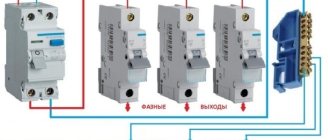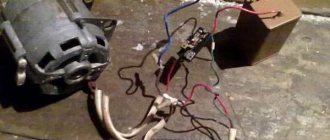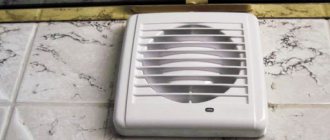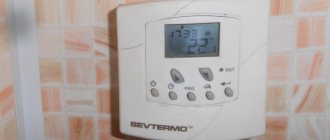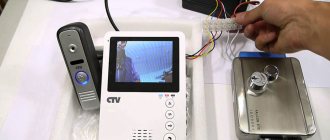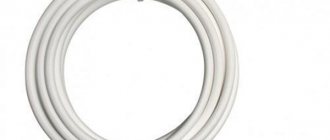Ventilation in any room provides a comfortable microclimate. In this case, a duct fan is installed in an apartment or industrial enterprise.
Such a device is part of a forced ventilation system. It provides the necessary recirculation of air flows both in an ordinary apartment and in a factory.
The specific model is selected depending on the type of ventilation pipe and the size of the room. Installation of duct fans can be carried out by both experienced craftsmen and beginners.
Scope of application of duct fans
An example of the use of duct fans in office ventilation
Duct silent models are mounted in various types of air ducts.
Such special ventilation equipment is installed:
- in retail outlets and various supermarkets;
- at bus and railway stations;
- in cinemas;
- in small manufacturing enterprises;
- in warehouses and various storage facilities;
- in large office premises;
- in restaurants, etc.
These products are also installed in the toilet or bathroom, laundry room, basement or basement.
Basic technical aspects
Tools and materials:
- alcohol;
- zero sandpaper;
- primer.
There are several types of fans that are used in everyday life:
Overall dimensions of window axial fans.
- Internal. They are usually used for large buildings and structures where large amounts of air under pressure need to be supplied. They are very powerful and durable, but the pricing policy is quite harsh. Their only downside is that they are difficult to maintain, since to clean such a fan in case of dust, you will need to disassemble the entire segment in which it is installed.
- External. They are popular among the average person because they are very easy to install, easy to maintain and inexpensive. They almost always have low power, so that they are enough only for a small room, but they are quite justified in everyday life. The only negative is the weak material, which can burst if subjected to improper physical impact.
In both cases, the installation is different, but the preparatory work is very similar:
- The space is cleared of foreign objects. You can leave only the electrical wiring, but check it separately.
- If necessary, the area is covered with a protective material, be it waterproof paint or primer.
- The surface is degreased using alcohol or any similar liquids.
Now the preparation for the installation process of the axial fan is completed, but the most difficult part is yet to come.
Types of duct fans
Depending on the design of the device, there are 3 types of duct silent fans:
- axial (asynchronous);
- centrifugal;
- combined.
In axial models, air movement coincides with the direction of rotation of the fan shaft. The efficiency of such ventilation devices is 75%.
Centrifugal (radial) devices extract air from industrial and domestic premises. A fan is installed in the bathroom, the blades of which are bent against the direction of rotation.
The operating efficiency of this device is approximately 80% and does not produce much noise when operating.
Combined models contain structural elements of both axial and centrifugal ventilation devices. The operating efficiency of such equipment is approximately 80%. The body shape can be rectangular, round or square.
Combined devices have high performance. This figure is higher than that of axial products, which is why such models are installed not only in multi-storey buildings, but also in industrial facilities.
Duct fans are also divided into two large classes (types):
- traditional;
- wall-mounted
Wall-mounted devices are complex devices that are configured during production. However, their installation process is much easier and faster.
Also, duct ventilation can be single- or multi-speed. Most ventilation devices have 1 speed, although two-speed devices are often found on sale.
Common mistakes and additional tips
Fan connection errors can cause not only incorrect operation of the hood, but also a short circuit or fire. Do not forget that the bathroom is a room with high humidity, which means it is especially dangerous for electrical appliances and wiring.
In order to arrange ventilation without errors on the first try, consider these tips:
- The fewer bends and the simpler the design of the ventilation duct, the better the traction.
- With a single ventilation system for a separate bathroom, air should move from the bathtub to the toilet, and not vice versa.
- Use terminal strips, not electrical tape, for all wire connections.
- Strip exactly the part of the wire that will go into the terminal block.
- Check that there is a mosquito net in the fan. If suddenly it is not there, add it, because mosquitoes and other insects feel great in warm, damp ventilation shafts.
- In a private house, be sure to insulate the part of the ventilation duct or shaft passing through unheated rooms. Otherwise, there will be no traction in cold weather.
- Don't neglect grounding for metal fans.
In addition, to prevent the fan from interfering with natural ventilation when it is turned off, you can use double rectangular grilles, with a hole for the fan at the top and a regular grill underneath.
When connecting the fan power supply, do not mix up the contacts: N – zero, T or LT – timer, phase from the switch, L or Line – phase directly from the box
If it is not possible to install a double grille, you can maintain natural ventilation by placing foam plastic legs 1 - 2 cm under the corners of the body, in the places where they are fastened with self-tapping screws. As a rule, the ventilation window is square and the fan housing is round, and these gaps are enough for air circulation.
Please note that even an ideally installed and sufficiently powerful fan will not work effectively if there is not sufficient supply ventilation. Usually it is provided by a gap of 1.5–2 cm under the door to the bathroom, but for beauty it can be replaced with a special grille that cuts into the bottom of the door.
Also make sure that fresh air gets into your home at all, because after installing plastic windows and new doors, insulating the walls and concrete screed on the floor, the apartment turns out to be hermetically sealed, like a thermos.
Additionally, the exhaust fan may need cleaning. Therefore, we recommend that you also read the step-by-step instructions for disassembling and cleaning the device. For more details, follow the link.
Design features and characteristics
In a long air duct, only a radial rather than an axial duct fan is installed. This is due to the fact that very often such devices are installed far from the exhaust opening of the ventilation duct.
As a result, the axial device, unlike radial models, does not effectively remove air flows from the bathroom and kitchen and does not eliminate unpleasant odors.
Duct fans have the following characteristics:
- productivity - up to 5330 m3/hour;
- power consumption - up to 3.5 kW;
- pressure - up to 900 Pa;
- flanges have a diameter of 100-400 mm;
- low noise level;
- the electric motor is equipped with an external rotor;
- equipped with speed regulators;
- Installing the device is a simple and quick process and does not require special experience.
It should also be noted that preventive inspection and cleaning of the ventilation device does not take much time.
Design and principle of operation
The body of the device can be made of metal or plastic. Products made of galvanized steel have the greatest resistance to corrosion. To improve sound insulation qualities, the walls are made of several layers.
The design also includes the following elements:
- impeller, on which the efficiency of the device depends;
- Electrical engine;
- a rotating impeller with blades attached to it (the latter ensure the movement of air masses in a certain direction);
- thermal protection block, thanks to which the fan can operate during temperature changes;
- lattice elements mounted on the walls and protecting the air duct from clogging.
Often the devices are also equipped with a speed controller. A capacitor can be used for starting. Some models are equipped with a check valve that prevents air from moving from the street into the building. This element may depend on the sensor or close spontaneously when the flow stops.
When the wheel rotates, an area of low pressure arises, air is sucked through the lattice parts and goes to the blade surfaces. The pressure increases and the flow moves through the network of air ducts in a certain direction. Overheating is prevented by thermal contacts that open the circuit when the temperature rises.
What is needed for installation
To install the fan in the ventilation duct, you need to prepare:
- air duct;
- the device itself;
- various shock absorbers;
- ventilation duct connectors;
- silicone inserts;
- several electrical cables.
Depending on the installation method of the product, the following tools are used:
- perforator;
- a hacksaw with fine teeth (for cutting the ventilation duct);
- electric drill, thin and thick drills.
In some situations, other devices are also used. This depends on the configuration of the ventilation ducts and the type of room (industrial or domestic).
Conclusions and useful video on the topic
The construction of a ventilation duct for autonomous ventilation of a toilet and bathroom with only one shaft is clearly shown in this video:
Connecting a simple fan is described in detail here:
To summarize, we can say that it is quite possible to independently arrange an effective ventilation system in an apartment, but you need to be careful and think through everything carefully in advance. If you are not confident in your abilities, entrust the job to a specialist, because mistakes in working with electrical wiring can lead to dire consequences.
Have you ever installed a fan in a bathroom or toilet? Please tell us what connection diagram you used and were there any difficulties in installation? Leave your comments, share your experience - the communication block is located under the article.
Installing a fan in the duct
Connections when installing a VK fan with square and rectangular air ducts of arbitrary sizes
Duct silent fans are easy to install. Products of this type are installed in several local ventilation systems, and not in one centralized branched ventilation duct.
In this case, the length of the air ducts is reduced and the financial costs of installing a ventilation system are reduced.
Similar models are installed:
- into a ruptured ventilation pipe;
- at the beginning of the ventilation system, if the device operates on inflow;
- at the end of the ventilation duct to ensure air removal.
The devices are installed on straight sections of the channel. At the same time, additional elements of the ventilation system (filters, distributors, etc.) are not installed in such places.
In order for the fan to be connected to the duct, they must match each other in equivalent diameter.
Its value is found using the following formula:
D=√4HB, where H is the height, B is the width of the ventilation pipe.
The distance from the fan inlet to the channel turn must be no less than the equivalent diameter of the device, and from the outlet to the next turn - at least three diameters. In this case, there are no aerodynamic losses in the pipe, and the ventilation system works normally.
During installation, first read the instructions for using the duct ventilation device - study the installation features and operating rules. If you cannot install the product yourself, it is better to contact an experienced technician.
When installing small models, no fasteners are used. Large ventilation devices, which are installed in industrial enterprises, are attached to the air duct using several hangers, supports and brackets.
The main thing in installation is to ensure a strong connection of all parts. For sound insulation, separate silencers are installed at the inlet and outlet of the ventilation device.
Duct fans work in any position!
When installing these devices, perform the following steps:
- an air duct with a length of at least 1.5 m is installed in front of the ventilation device;
- flanges with a diameter of more than 400 mm are secured to the air duct with bolts and special brackets;
- the ventilation device is mounted on steel brackets or separate hangers;
- leave free space around the device for future maintenance work;
- duct ventilation, which is installed in the kitchen, is installed with the socket (funnel) upward.
The air duct is connected to the ventilation device using special clamps. To output the electrical cable in such a situation, a cable channel is used.
Installation Features
Before starting installation, it is necessary to register and approve this project with the government agencies responsible for the operation of the building . It should list the conditions for using the entire future ventilation system, the procedure for performing the work, the materials used and the layout of the ventilation air ducts and shafts.
Duct fans can be installed anywhere in the air duct and at any angle; the most cost-effective option is the rectangular cross-section of all air ducts, which saves free space.
To increase productivity, several fans are installed in parallel, and to increase the operating pressure they are mounted in series.
For ventilation of any size bathroom, one duct product is sufficient. To ensure tightness, special components are used, and to eliminate unwanted vibration, gaskets made of a material that absorbs the negative effects of vibrations and reduces noise from the operation of the device are used.
To implement the necessary control over the parameters of the product, tracking systems are installed, if such actions are necessary. The control panel is placed in a convenient place; special thyristor-type devices are used to adjust the rotation speed.
Installation of fans in a square duct
Rectangular pipes of the ventilation system come in 2 types - ventilation ducts of equal cross-section and pipelines of arbitrary size. Duct silent fans are often installed in the first of them.
Installation of such a product is quick and simple. First, it is mounted inside the ventilation duct, and then, using flanges, sections of the air duct are connected to each other and the tightness of the joints is checked.
This installation ensures optimal air movement speed and quiet operation of the ventilation device.
During installation, the connecting steel flange of the ventilation pipe is gradually increased to certain dimensions. If the square cross-section of the ventilation duct is larger than the inlet opening of the ventilation device, then the air duct on this side is carefully narrowed to the diameter of the flange.
If the cross-section of the ventilation pipe is smaller, then the entrance to the pipeline is gradually expanded. This expansion is performed with an angle of up to 10 degrees on one side.
Before correctly installing a specific duct fan, first carefully study its installation diagram to find out what position the motor should be in - vertical or horizontal.
If installed incorrectly, the device will have zero efficiency.
Advantages and disadvantages
The devices are attractive due to their ease of installation and wide range of applications. Most of them operate quietly. They do not require special care - it is enough to wipe the body and blades from dust every few months. The electric motor is protected from voltage surges, which minimizes the likelihood of failure.
The downside of fans is the lack of an air filtration option. If there is a need for it, it is advisable to install other devices, for example, air purifiers.
Installation of fans in a round duct
Installation of duct fans in a round ventilation pipe is often carried out using an adapter. Using this part, devices with a square flange are combined with the opening of round channels.
In this case, the length of the steel adapter is equal to 1⁄2 the length of the channel device. The diameter of the flange must match the size of the air inlet duct.
If the diameter of the ventilation pipes is larger than the dimensions of the device flange, then when installing a silent duct fan in the air duct, a conical transition is used. Its opening angle is 8-10 degrees.
A special collar flange is also installed in the air duct, which ensures a strong connection of all parts of the air duct.
content .. 41 42 46 ..INSTALLATION OF FANS
Radial and axial fans for general purposes. According to the degree of installation complexity, fans can be divided into three groups:
weighing up to 50 kg - radial up to No. 3(2, axial up to No. 8; the overall dimensions of such fans are small and there are no difficulties with their transportation and lifting to the installation site, so this work can be done either manually or using mechanisms;
weighing up to 1500 kg - radial fans up to No. 12.5, axial fans over No. 8 and all roof fans; Such equipment is supplied in the form of fan units, i.e. complete with an electric motor, frame, and V-belt drive. Installation of fans is usually carried out without disassembling ai regatta. Transportation and lifting to the installation site require installation openings and lifting mechanisms;
weighing over 1500 kg - radial No. 16 n above; supplied in separate enlarged blocks; fan casing consisting of several parts, drive, frame, shaft with impeller, vibration isolators. Installation of fans usually begins with the delivery of enlarged blocks to the installation site, where the unit is assembled directly on the foundation.
Before installing fans, it is necessary to: accept the ventilation chambers, platforms, foundations and other supporting structures for installation; inspect the fan near the electric motor; compare their data with the design data; prepare and install lifting devices and mechanisms in accordance with the instructions of G1PR; check the overall dimensions of installation openings and passages; deliver fans or enlarged units to the installation area.
When inspecting fan units, check the type of fan, the direction of its rotation, the number, design, type and brand of the electric motor, its power, rotation speed, and pulley diameters. If one or more parameters do not correspond to the design data, installation of the fan can be permitted only after the changes have been agreed upon with the design organization.
Radial fans of the 1st and 2nd groups up to No. 12.5 inclusive are mounted in the following sequence: sling the fan;
raise (lower) the fan to the level of the design mark as close as possible to the installation site and move it horizontally to the design position;
check the correct installation of vibration isolators and the uniformity of their compression, horizontalness, accuracy of connection to structures, horizontality of the impeller shaft;
Before connecting the air ducts, check the balancing of the impeller, the tension of the V-belt drive belts, and the fastening of the guard;
perform an inspection of the impeller shaft and electric motor bearings and determine the presence of lubricant;
check the insulation of the electric motor windings and connect the power supply; this work is performed by electricians;
check the operation of the fan, including the correct direction of rotation of the impeller.
Currently, pre-installation inspection and rotation of fans are being implemented at factories, installation organizations or customer warehouses.
Depending on the decision made in the PPR, local conditions and the availability of mechanisms, fans are lifted by various lifting mechanisms - truck, tower and bridge cranes, winches, electric hoists, forklifts. Horizontal movement of fans to foundations and platforms is carried out on rollers made from pipe scraps using winches or manually.
Fans can be installed on the foundation by rolling them using hand winches along joists laid on the foundation at a slight angle.
Radial fans are usually installed on spring vibration isolators. If the fan is installed directly on the floor, then DO type spring vibration isolators are not attached to the floor. When installing fans on metal structures or foundations, spring vibration isolators are bolted to them through the holes in the bottom plate of the vibration isolators. Elements of metal structures and embedded parts to which vibration isolators are attached must coincide in plan with the corresponding elements of the fan frame so that the position of the vibration isolators can be adjusted.
If the layout of the fan unit does not correspond to the design one and the center of gravity of the unit is shifted from the design position, then the location of the vibration isolators is determined experimentally. To do this, the fan is placed on vibration isolators and, by moving them along the frame, their uniform settlement and horizontal position of the frame are achieved. When adjusted, the more compressed shock absorbers are moved away from the intended center of gravity of the unit. Having marked the final installation locations of the vibration isolators, holes are drilled in the unit frame for their fastening.
High-pressure and dust fans are usually installed directly on concrete foundations and for fastening they use anchor bolts, which are inserted with the threaded part from below into the fan frame. The bolts are screwed with nuts and locknuts, lowered into their sockets and filled with cement mortar. After the solution has set, check that the fan is installed correctly at the level. If required, metal shims are placed between the frame and the foundation and the anchor bolt nuts are finally tightened. Then the foundation is filled with cement mortar to the level of the lower part of the frame.
When installing fans on a rigid base, in some cases sheet rubber up to 20...25 mm thick is placed under the fan frame to reduce the level of mechanical vibrations. In this case, rubber washers are placed under the nuts of the anchor bolts, and the holes for the bolts are made of a much larger diameter to prevent contact between the frame and the bolts.
Before connecting air ducts to an installed fan, check the static balancing of its impeller. To do this, remove the V-belts if the fan is equipped with a V-belt drive, and mark it with chalk on the impeller, which should rotate freely by hand. The same mark is applied opposite the one made on the inlet pipe. The impeller is turned so that it completes several revolutions, and the position of the marks is observed. If, during several such operations, the risk on the impeller occupies various arbitrary positions, then the wheel is correctly balanced. If the wheel stops in one specific position, then a weight should be attached to the top of the front rim of the impeller and all operations should be repeated. Having determined the mass and position of the load at which indifferent equilibrium of the impeller will be observed, a steel plate of the same mass is welded to it in the found place of the rim using a design seam.
Radial fans of the 3rd group No. 16 and above are mounted from separate enlarged assembly units in the following sequence:
individual assembly units, including a casing consisting of several parts, are delivered to the installation site, unpacked and unpreserved;
assemble the fan frame and install it together with vibration isolators on a verified foundation, placing temporary supports (wooden blocks);
install the lower part of the casing and drive parts on the frame on wedges;
the drive, including the shaft with the stand, is secured to the frame and the impeller is mounted on the shaft;
the upper part of the casing is fed and bolted to the lower part, using sealing gaskets;
install and secure the inlet pipe with a flange to the casing;
using wedges, check the location of the casing relative to the frame and stand and achieve the required gap between the fan impeller and the inlet pipe and secure the casing. This gap (Fig. 102) affects the characteristics of the fan and should not exceed 1.0% of the diameter of the impeller (node 1). If necessary, the gap size is adjusted by moving the inlet pipe along the flange;
After checking the gaps in the pipe, holes are drilled in place and the pipe is secured to the casing;
check the presence of lubricant in the bearings and install vibration isolators so that they are evenly loaded;
check the horizontality of the impeller shaft; deviation of the shaft from the horizontal position is allowed no more than 0.5 mm per 1 m; The horizontalness of the shaft is adjusted using the vibration isolator adjusting nuts;
after checking the tension of the V-belts, the quality of insulation of the electric motor windings, the free rotation of the impeller without jamming and the tightening of all bolted connections by briefly turning on the electric motor of the fan unit, determine the correct direction of rotation of the wheel;
carry out a test run and run-in with the flexible inserts of the suction and discharge pipes connected to the air ducts.
For fan units in which the fan is connected to an electric motor by a V-belt drive, a cord attached to the side edges of the pulleys is used to ensure that the pulleys are parallel and that the belts are not kinked. The V-belt drive must have a guard that prevents accidental contact with rotating parts.
The couplings with which the fans are coaxially connected to the electric motor must have a guard in the form of a curved metal sheet attached to the stand.
Radial fans can be installed on brackets if the fan number does not exceed 6.3. The brackets are mounted on the walls (Fig. 103) or on the columns of buildings.
Axial fans of the 1st and 2nd groups are installed directly in air ducts, on brackets, in wall and window openings.
Rice. 102. Alignment of gaps when assembling the fan
The installation height of axial fans usually significantly exceeds the height of the working area, and they are installed using forklifts, truck cranes or winches.
When installing axial fan 1 in the air duct (Fig. 104), the fan must be secured to the base or bracket 2, and the flanges of the casing are connected with bolts with a rubber gasket to the flanges of the air ducts 5. A hatch is made in the air duct located on the electric motor side to connect the fan to electrical network and preventive maintenance.
Rice. 103. Installation of fan V-Ts4-70 No. 4 on brackets: 1—strut, 2—console, 3—link, 4—rubber gasket, 5—bolt with nut and locknut
Cassock. 104. Installation of the main fan in the air duct: 1 - axial fan, 2 - bracket, 3 - ceiling, 4 - hatch, 5 - air duct
When installing an axial fan in a wall opening, it is bolted to the embedded metal frame framing the opening. To protect against precipitation, a semi-bend is installed on the outside. Axial fans mounted in wall or window openings are equipped with valves, the control of which should be located in the room at a height of 1.5...L.8 m from the floor.
Installation of axial fans is carried out in the following sequence: install and align the bracket, frame or hangers for attaching the fan; mount the fan in the designed position and secure the support bolts; check the gaps between the shell (cylindrical body) and the impeller (blades); the gap must be uniform and not exceed 1% of the impeller diameter; connect the electricity, check the correct direction of rotation of the impeller and run in the fan.
content .. 41 42 46 ..
How to install a duct fan in a pipe
Installation of duct silent fans in a pipe is carried out in the same way as the installation of these products in a round air duct.
However, in this case, the diameters of the elements being connected, as a rule, do not coincide. Therefore, steel adapters are most often used.
Sometimes these parts are made from scrap materials, for example, galvanized steel. The steel adapter is installed in the gap, and then the pipe joints are sealed.
Also, when installing a ventilation device, couplings and clamps are used.
Channel check
Before connecting the fan, you need to check the condition of the ventilation shaft.
Some people recommend this method by holding a sheet of thin paper to the vent. It should be attracted if the hood is good. But it’s more reliable to check with a flame, using matches or a candle. Light a candle and bring it to the hole, the flame should seem to stretch towards the channel. If this does not happen and the flame is even, it means that the ventilation duct is clogged and requires cleaning. To do this, you need to contact special housing and communal services.
Electrical connection
The duct fan is connected to the home electrical network strictly in accordance with the operating instructions. In this case, electrical wiring elements such as cables and terminal blocks are used.
The instrument terminals have the following markings:
- “L” - phase conductor;
- "N" - zero core;
- “T” - signal wire (in models with a timer).
The neutral conductor is blue, the phase conductor is brown or white. When connecting a duct fan to the electrical network, the cable cores are connected to the device terminals.
When connecting the ventilation device to the power supply, perform the following steps step by step:
- unscrew the cover of the terminal box of the ventilation device;
- there is a latch in the cover where the wires are inserted;
- connect the wires to the “linear phase” and “zero” terminals;
- close the lid of the terminal box;
- check the connection - plug the device into the outlet.
In this case, they do not install a separate switch, since when using such a ventilation device, they often use a remote control that regulates the volume of air masses, and also turns the device on or off.
A silent duct fan is connected to a power supply with a voltage of 220 V. Today, various companies produce economical models with low power consumption.
As a rule, the engine of such a device is equipped with a built-in temperature sensor with the ability to restart. Thanks to this, the electric motor of the device does not overheat.
Connecting a fan without a timer
This connection option is considered the simplest from a technical point of view. The switch is placed in front of the entrance to the bathroom or indoors. It is advisable to install it away from plumbing equipment, where splashes on electrical contacts are prevented.
Plastic axial fans do not have a terminal output for connecting a ground loop. Everything is limited to phase switching with a neutral conductor. Connections are made in a distribution panel or socket box up to 60 mm deep.
To a separate switch
This is the most common connection option.
You will need to perform the following wiring connections:
- the neutral conductors of the ventilation unit and the electrical network are connected and insulated;
- the hood and switch phases are paired in the same way;
- The phase conductor of the electrical network is connected to the input terminal of the switch.
An important condition is the connection of the ground loop.
To the switch shared with the light
It is convenient when the ventilation unit starts at the same time as the lighting fixtures are turned on. The most practical option is to combine it with a two- or three-key switch. A socket box is installed in the corresponding hole. Electrical switching is carried out in it.
The input terminal is connected to the phase conductor of the power supply network. The output contact closes to the phase of the climate control unit. After connection, it is necessary to check the reliability of the connection and the integrity of the insulation. Then the working mechanism is fixed in the socket box and the cover with keys is installed.
conclusions
Modern duct fans have the following advantages:
- don't make noise;
- compact;
- have high performance;
- they can be easily and quickly installed in the duct.
When selecting a device, the following indicators are taken into account:
- Operating temperature range;
- performance;
- noise level.
When purchasing and installing it yourself, you need to follow all the nuances that were listed above in the article.
Application area
Duct fans are used in households and commercial premises (shops, catering establishments, etc.). For narrow industrial purposes, models with special properties are designed. There are models adapted for high humidity conditions, such as bathrooms and toilets. You can organize the hood mount so that it turns on simultaneously with the lighting. One of the supply conductors is opened and connected to the switch. If the latter has two buttons, do it differently: one of them is connected to the lighting device, the other to the ventilation device.
WORK QUALITY REQUIREMENTS
Fans supplied by manufacturers must meet the requirements of GOSTs or technical specifications for their manufacture.
Design:
VO fans are manufactured according to:
— TU 4861-024-15185548-04;
— GOST 11442-90.
Terms of Use:
Axial fans
are designed for moving non-explosive gaseous media with a temperature not exceeding 50 ° C, containing solid impurities not exceeding 100 mg/m, not containing sticky substances and fibrous materials, in temperate climate conditions of the 2nd category of placement according to GOST 15150-90, with ambient temperature environment up to plus 40 °C.
Aerodynamic characteristics
Noise characteristics of VO 200-4E
Octave frequency bands, Hz
To determine the serviceability of equipment received for installation, a complete or incomplete audit is carried out; a complete audit is necessary if the storage conditions and period of equipment or transportation conditions are violated. During a complete inspection, all assembly units and parts are disassembled, washed and checked. In case of incomplete audit, perform:
— additional staffing of the ventilation unit (if necessary);
— depreservation of parts and assemblies from film coatings;
Connecting a fan with a timer
Units equipped with a timer are easy to use.
The operating principle of such a device is as follows:
- The fan starts in parallel with the lighting.
- After the light turns off, the unit rotates for a user-specified time, removing exhaust air from the room.
- Then it turns off automatically.
To ensure full functioning of the device, 4 cores are used:
- phase from the distribution panel;
- electrical wire connected to the light bulb;
- ground loop;
- zero core;
For self-installation, it is recommended to purchase a surface-mounted device with the necessary set of built-in sensors - humidity, motion, etc.
To a single-key switch
You can turn on lighting and ventilation with one button, but with a slight delay in starting the climate control unit. Some models are equipped with an electronic timer. Such devices provide the ability to select a functional mode. Their switch is implemented in the form of 3 pin contacts. Two of them are closed with a jumper - a special jumper. One mode is called "toilet". To activate it, the upper and middle contacts are closed.
The meaning of this mode is that when power is applied, the motor of the ventilation unit starts immediately. The second mode is called “bathroom”. The light turns on immediately after pressing the switch key, and the cooler starts working with a set delay. In this mode, the unit will start only if the time interval between turning the lighting on and off is at least 90 seconds.
To two-button switch
When connecting an exhaust unit to a two-key switch, the phase is interrupted at one of the contacts. This method of electrical switching allows you to turn on ventilation and lighting separately. The neutral and phase conductors of the power supply system are closed at the corresponding outputs of the terminal block of the device. The control phase is located on one of the switch keys. It is connected to the timer contact of the exhaust device.
The operation of the unit is controlled and the operating mode is set through it. This wire is color coded brown. You can use the green-yellow wire, which is not used for this type of connection, which is responsible for grounding. In this case it does not start on the cooler. To connect the exhaust unit to a two-button switch, it is recommended to use a three-core power cable. This will allow for separate or paired operation of lighting and ventilation.
What is needed to install forced exhaust
To find out whether forced exhaust is needed in the bathroom, the state of natural ventilation installed during the construction of the house is analyzed. To check the hood, remove the decorative panel from the ventilation shaft and remove accumulated debris from the ventilation duct, which in the bathroom is usually located close to the ceiling. Then bring a lit match or candle to the ventilation duct. If the flame does not deviate to the side or deviates very slightly, a decision is made in favor of installing forced exhaust.
It is necessary to ensure a flow of fresh air into the bathroom. Typically, air circulation is organized through a small gap under the door in the bathroom. Therefore, when the door frame is installed, the threshold in the bathroom is not installed.
When choosing a fan for the bathroom, you must carefully study the characteristics of the device. The device must fully comply with the conditions in which it will be used. The fan must have sufficient capacity to provide the required amount of fresh air. Important factors when purchasing a device will be price, design, and noise level.

